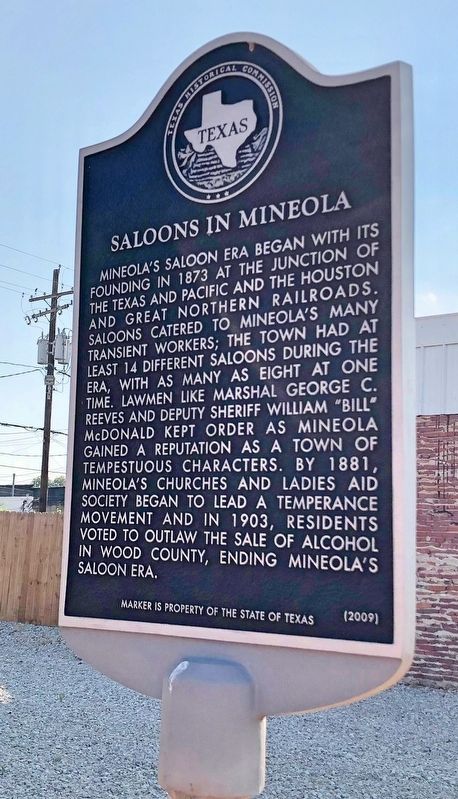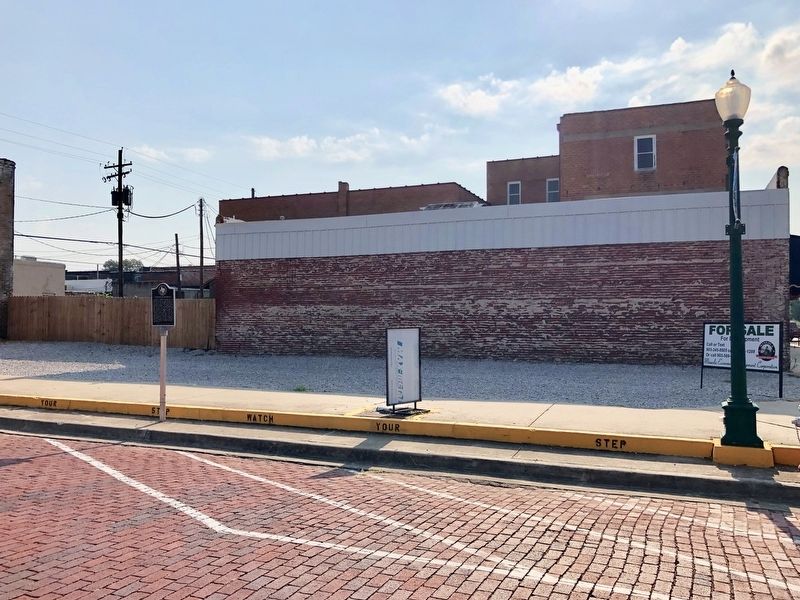Mineola in Wood County, Texas — The American South (West South Central)
Saloons in Mineola
Erected 2009 by Texas Historical Commission. (Marker Number 15956.)
Topics. This historical marker is listed in these topic lists: Notable Buildings • Railroads & Streetcars. A significant historical year for this entry is 1873.
Location. 32° 39.768′ N, 95° 29.364′ W. Marker is in Mineola, Texas, in Wood County. Marker is at the intersection of South Johnson Street and Commerce Street, on the left when traveling south on South Johnson Street. Touch for map. Marker is at or near this postal address: 101 South Johnson Street, Mineola TX 75773, United States of America. Touch for directions.
Other nearby markers. At least 8 other markers are within walking distance of this marker. Site of the Coleman Family Drug Store and Clinic (within shouting distance of this marker); C. W. Raines (within shouting distance of this marker); Mineola (within shouting distance of this marker); Mineola's Jewish Community (about 300 feet away, measured in a direct line); Railroads in Mineola (about 300 feet away); First National Bank Building (about 300 feet away); Site of Public Mineral Water Well (about 300 feet away); The Dixie Overland Highway - The Jim Hogg Highway (about 400 feet away). Touch for a list and map of all markers in Mineola.
Regarding Saloons in Mineola. Ellie Reeves, an early resident, said, "A man named Schwartz came to Mineola and opened its first saloon." Through the 1870s, 1880s and 1890s, the establishments in town included Blasingame's, Little Abe's, Sam A. Joseph and Bro. Pickard's. J.H. Cofield and the Exchange Saloon, Dave Kitchens, J.J. Patterson, J.M. Audrey, Wren Bros., C.C. Mansell, Breck's Saloon, Johnson Street Saloon, the Palace Saloon, James Bryan's and the Horseshoe Saloon.
Advertisements in the local newspapers touted their finest whiskeys, coldest beer, fine brandies and cigars, billiards and wine.
During this period, William Jesse "Bill" McDonald was a deputy sheriff and George C. Reeves was city marshal. Bill McDonald was later named as a captain in the Texas Rangers by Governor Hogg. Today there is a street in Mineola named for him. Additionally, Bill McDonald owned what was called "an opera house" on the corner of South Johnson and Commerce Streets in Mineola. An opera house in that period did not present classical opera. Entertainers performed concerts and various programs for their audiences.
In the timber area adjacent to Mineola, there was some 300 tie-cutters encamped. They supplied cross-ties for the I&GN Railroad. These men were a drinking and lawless lot. On Saturday nights, the Mineola streets were filled with riot and disorder. The city marshal, George Reeves and Deputy Sheriff McDonald had, on several occasions, made arrests. Such enforcement of the law was regarded by the tie gang as an affront to them. They sent word to the officers that they would be on hand in full force on the following Saturday and that the calaboose (jail) might as well go out of commission as far as they were concerned.
One news writer wrote that the saloons were full and the men were getting constantly more noisy and quarrelsome. Finally McDonald and Reeves rounded up the drunken men and took them to the jail. They used a boxcar on a nearby rail line as an annex for the jail. The jail mentioned here was located on the corner of East Broad Street and North Johnson Street where today there is a Chevron Station. From Wood County history published in 2011
Credits. This page was last revised on September 5, 2019. It was originally submitted on September 5, 2019, by Mark Hilton of Montgomery, Alabama. This page has been viewed 260 times since then and 20 times this year. Photos: 1, 2. submitted on September 5, 2019, by Mark Hilton of Montgomery, Alabama.

